One of Scotland’s most famous road trips lies along the very northern coast of the country, drawing tourists from all over the world to the remote highlands and for good reason. As you venture north through the wilderness of the central highlands, the sights, sounds, and landscape around you begin to transform into that of a fairytale.
Suddenly, the tales of giants, dragons, and monsters do not seem so far-fetched. Mountain peaks tower around you and the weather blows a gale on your back, preventing you from returning to the safety civilisation. Not much else to do but continue on to the breathtaking land that awaits you on the epic North Coast 500 Road Trip.
No time to read now? No problem, save a pin to your Pinterest board for later!


North Coast 500 Highlights
19 Best Sights Along the NC500
With so many beautiful sights to see around this fascinating and ancient part of the world, planning a trip around the North Coast 500 can be an intimidating thought. To help you along we have listed all of our NC500 highlights, the best things do on N500 that you cannot afford to miss. Table of Contents
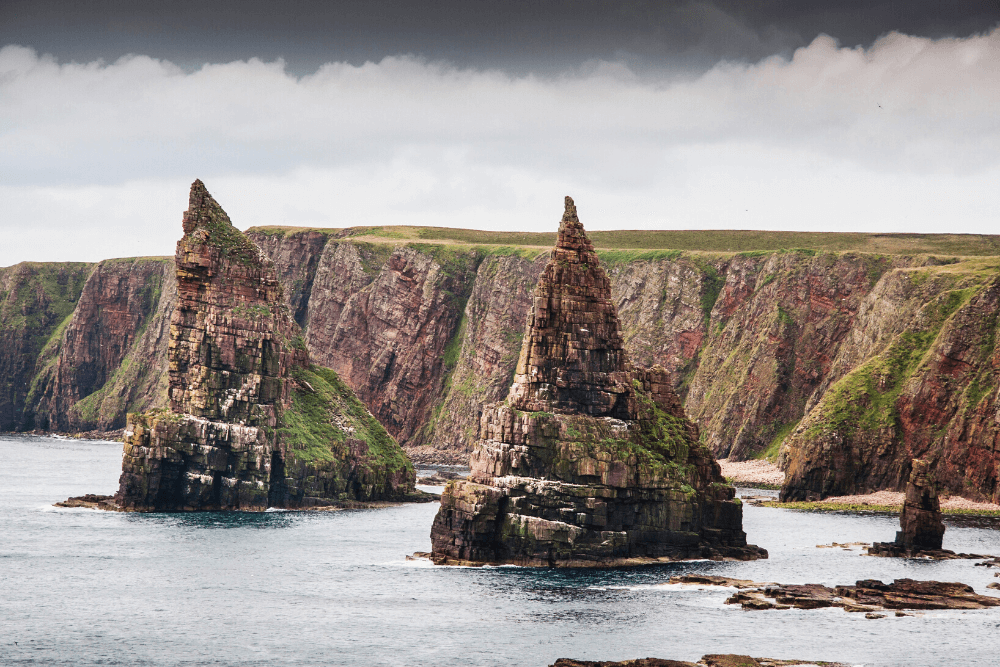
Where to Stay on the North Coast 500
There is a wide range of accommodations around the NC500 route, so you will not be short on options. Depending on how long you are spending in each area will depend on how long you spend in that location. It is worth bearing in mind that some accommodations will require you to stay a minimum number of nights so it is worth researching this when you are planning your North Coast 500 itinerary.
Our new book North Coast 500 Where to Eat and Stay shares the best places to eat and stay around the NC500 and includes whether places are dog friendly, accessible, have wifi and EVC and whether they cater to dietary requirements. Paired with our Destination NC500 guidebook you will have the perfect combo to start planning your roadtrip of a lifetime.
The remoteness in the highlands of Scotland will leave you with little choice of accommodation in each location along the NC500, however, there are still enough options to choose from to ensure a comfortable trip. These are mostly in the shape of B&Bs, Airbnbs, converted cottages and other quirky accommodations.
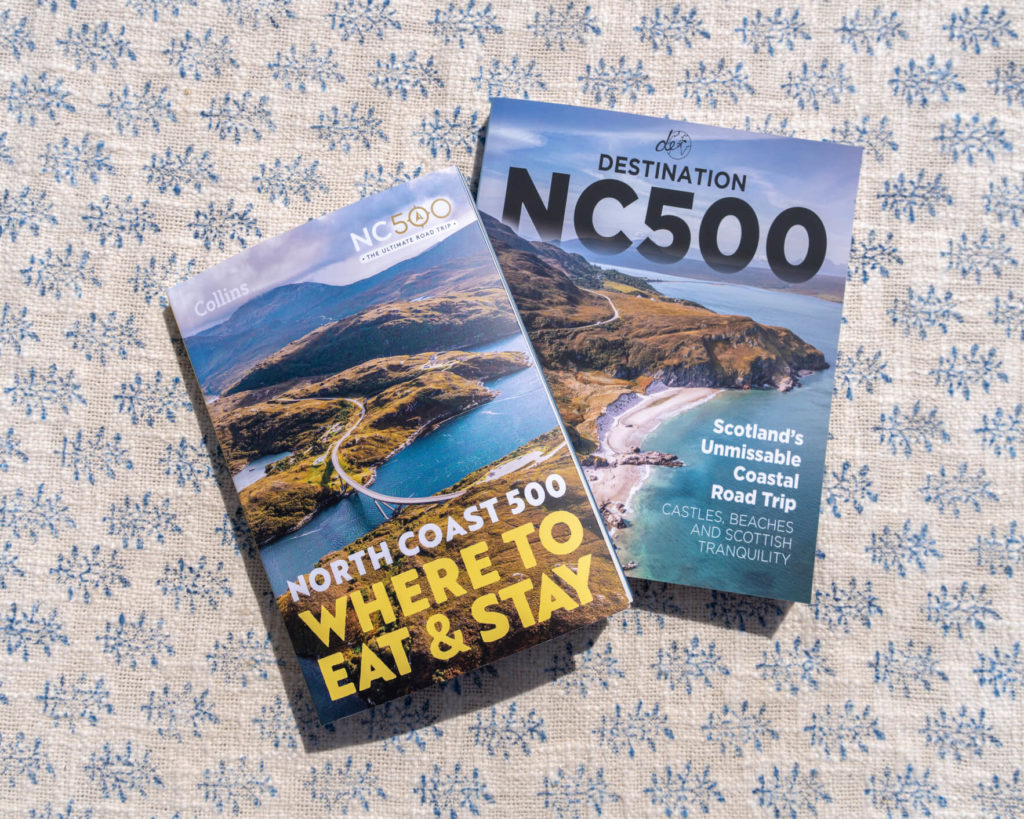
Planning Your Trip
We use the below booking platforms to plan our trips. We hope you find them useful too!
What is the North Coast 500
The North Coast 500 is the world-famous road trip stretching along the northern coast of the Scottish mainland. Officially launched in 2015, this 516-mile route has seen 30,000 new visitors head to the northern wilderness of Scotland, boosting the economy by more than £9million.
The official starting point of the NC500 is the northern capital of Inverness, which also happens to be the finishing point of this circular road trip. The best part of this route, however, is that you can start and finish it wherever you please, taking as long or as little time as you like on your trip.
The best length of time to see and do as much as you possibly can along this beautiful route is around one week. We recommend spending at least this amount of time exploring the NC500 in order to really make the most of each stop and truly appreciate the beauty around you.
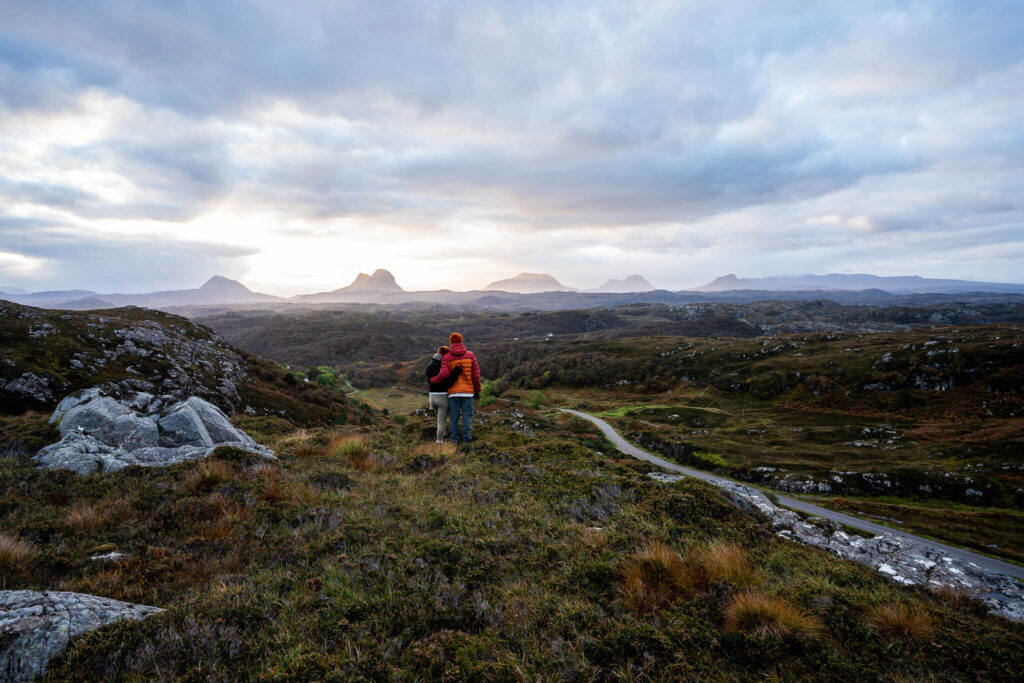
The Best Time to do the NC500
Scotland is one of those countries that is ideal to explore any time of the year. From November to February, the country witnesses the winter season. The temperature during these months varies from fairly cold to extremely chilled with snow. Many travellers prefer to visit the North Coast 500 in winter due to the route being quieter but most likely not to sunbathe on the beaches.
The spring season begins in the month of March and lasts until April. Though the weather remains quite pleasant during this time. The mountains still remain quite cold while snow still covers the peaks.
The best time to visit the beach is the summer months, i.e., July to August. This is the time when the temperature is averaging at around 19°C.
This is also the busiest time of the year in Scotland. The temperature remains fairly warm and hence, the perfect time to visit the NC500.
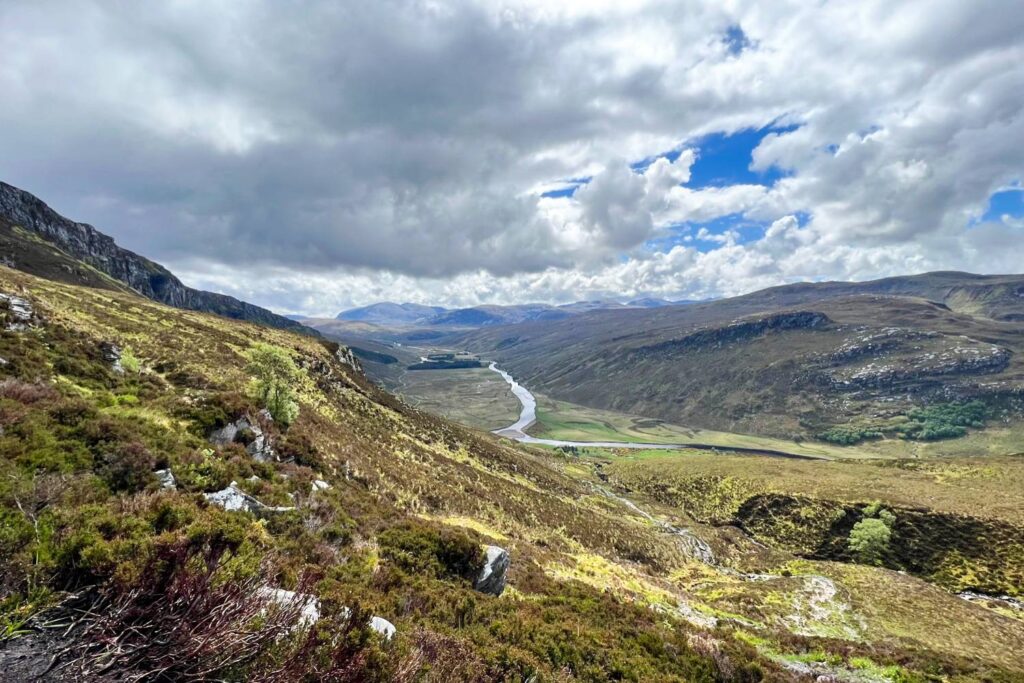
Best Sights Along the North Coast 500
There are so many beautiful sights around the 500-mile road trip of the NC500, however, we have managed to narrow this massive list down to just 19 of our favourite spots along the route. Feel free to see as many (or as little) of them as you wish, however, we recommend spending a good amount of time at each one, rather than squeezing in too many and not spending the appropriate time at each. In our guidebook Destination NC500 you will have access to over 110 of our favourite places to visit around the NC500 route.
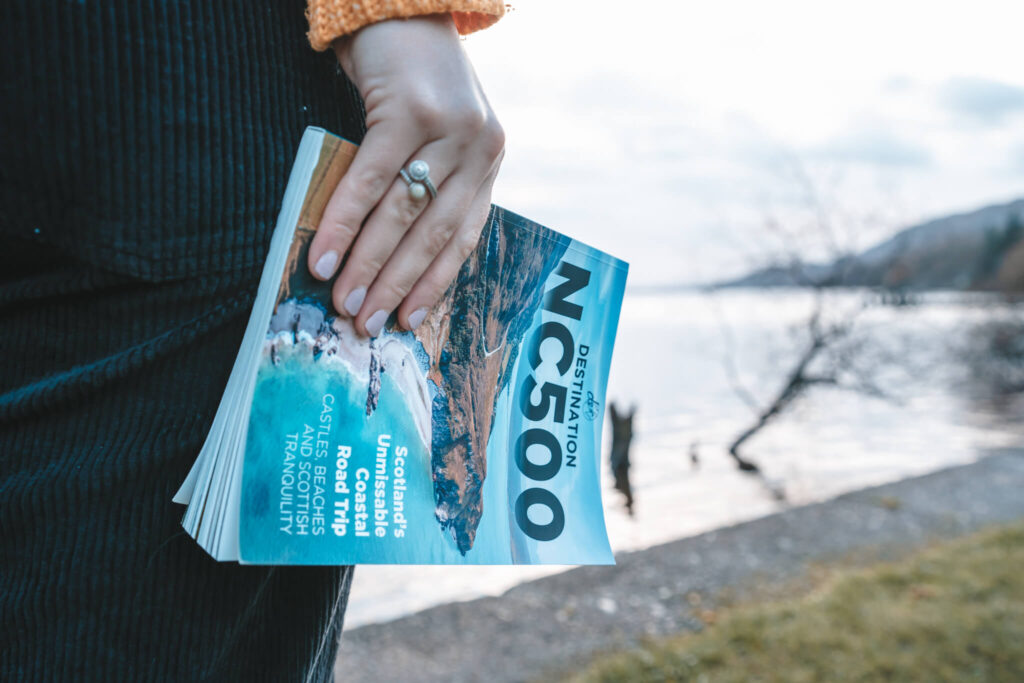
NC500 Motorhome and Campervan Scheme
The NC500 Motorhome Scheme, officially known as the Highland Campervan and Motorhome Scheme, was launched by the Highland Council on July 1, 2024. This innovative initiative is designed to address the growing number of motorhomes and campervans traveling along the popular North Coast 500 (NC500) route, ensuring that their impact on the local environment and communities is managed sustainably.
The scheme offers a voluntary seven-day pass costing £40, inclusive of VAT. This pass grants motorhome and campervan users access to 12 designated overnight parking locations along the NC500 route, including scenic spots like Torvean Car Park in Inverness, Nairn Harbour, Dunnet Head Car Park, and Ullapool Latheron Car Park.
These parking spots are available on a first-come, first-served basis from 10 PM to 8 AM, with a 72-hour no-return policy at each location. This ensures that the facilities are used responsibly and that a larger number of travellers can benefit from them.
Overall, the NC500 Motorhome Scheme provides a structured and sustainable approach to motorhome travel in one of Scotland’s most scenic and popular areas. We think this is a great idea and encourage everyone to take advantage of it if you are looking to explore this road trip soon.
Read all about this new scheme in our complete guide to the NC500 Motorhome Scheme here.
For more information or to purchase a membership, travellers can visit the Highland Council’s official website.
Falls of Shin
Located on the Eastern coast of northern Scotland, the Falls of Shin will be one of your first stops after Inverness if you are heading anticlockwise around the route. This spectacular set of waterfalls may not be the tallest in the world, however, at certain times of the year, they produce one of the most fascinating sights on the NC500. From mid-May until late Autumn, the Falls of Shin becomes a showground for the natural phenomenon of the leaping salmon.
Making their way back inland to spawn the next generation, salmon are frequently spotted leaping up these shallow falls. Despite the small size of the falls, to actually see these beautiful creatures getting enough air to leap each step of the waterfall is a beautiful and spectacular sight.
The cafe and gift shop are currently closed, however there are toilets open. Check the website for a full list of the opening hours.
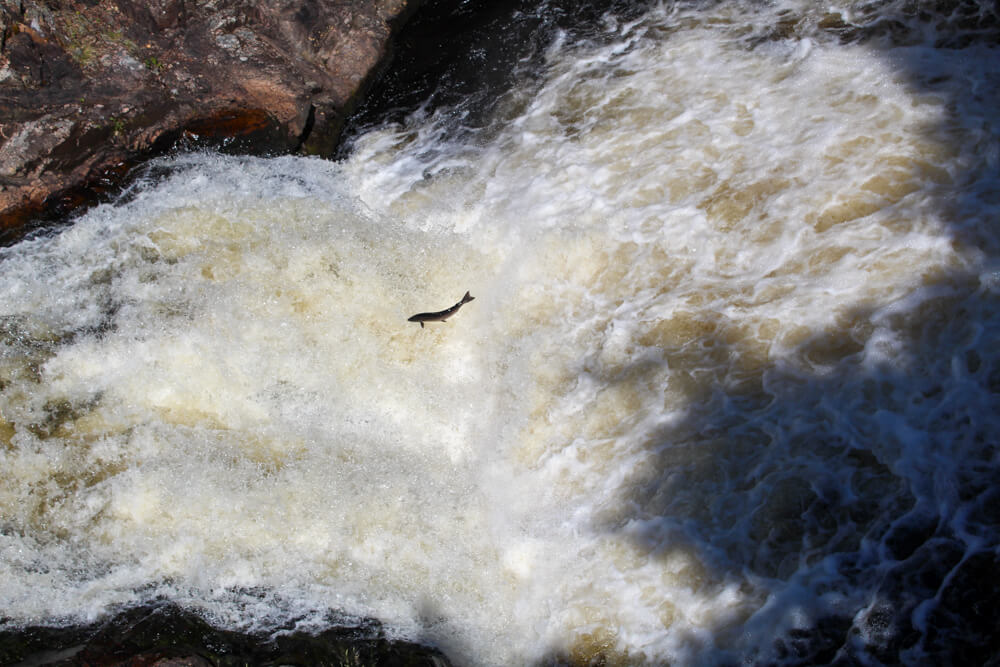
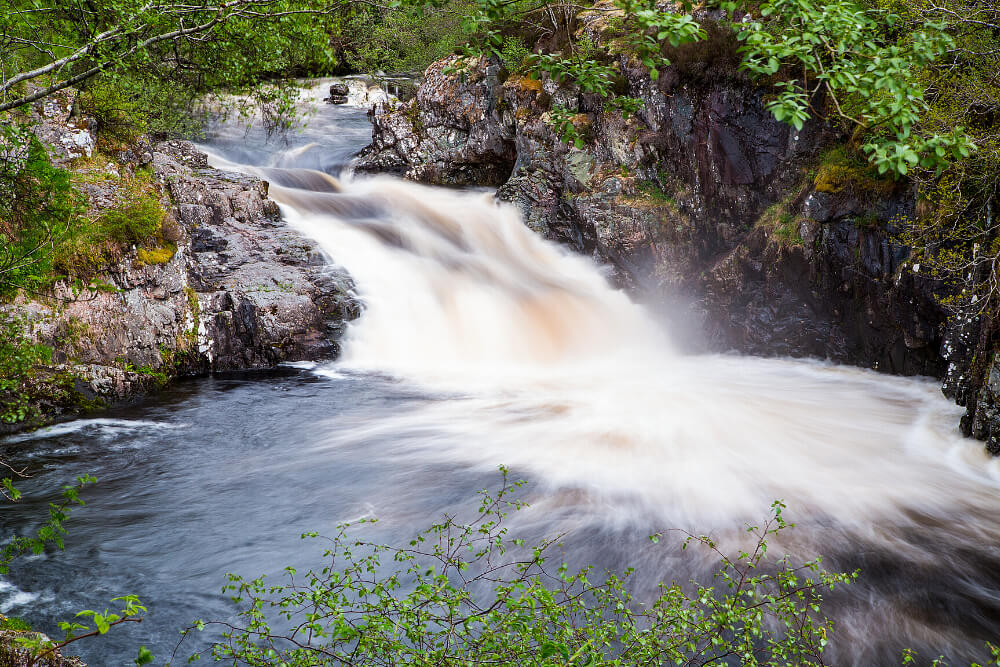
Dunrobin Castle
One of Britain’s oldest continuously inhabited houses sits just north of the beachside town of Dornoch, Dunrobin Castle. This beautifully restored building dates back as early as the beginning of the 13th century and is believed to have had residents living within ever since.
Dunrobin Castle is one of the most beautiful castles on the NC500 and the success of this castle can be attributed to the stature of the owning families, believed to have been the Earldom of Sutherland. As one of the seven ancient earldoms of Scotland, the Sutherlands were one of the most powerful families in Britain. As much as this sounds like it is from a fairytale, the castle has the looks to match, sitting high up from the nearby banks of the North Sea.
The beautiful gardens situated below the house make for a peaceful spot to wander on a crisp, spring morning, and are the perfect place to admire the amazing architecture and towering spires of the castle.
The castle is open to visitors between April and October, with varying opening hours for the different seasons. Check the website for a full list of opening hours.

Dornoch Beach
The golden sands of Dornoch Beach are a beautiful place to stop off on your journey along the eastern coast of Scotland. As you walk along the endless sands, fresh breeze blowing in from the open sea, it is not hard to see why this beach was given a Seaside Award status as a clean bathing beach.
This beach was one of our favourite wild camping spots on the NC500, due to how remote, tranquil, and beautiful the scenery is. We cycled deep into the beach where there was no one else around to set up our tent and had an incredible night under the stars.
In the town centre of Dornoch itself, there are lots of cute cafes and warming pubs for you to enjoy after a day in the fresh air. One cafe that we recommend you do not miss is the award-winning Chocolatier, Cocoa Mountain. Noted as the “best hot chocolate in the world”, it is easy to see why this would be the case as this indulgent hot drink is simply to die for.
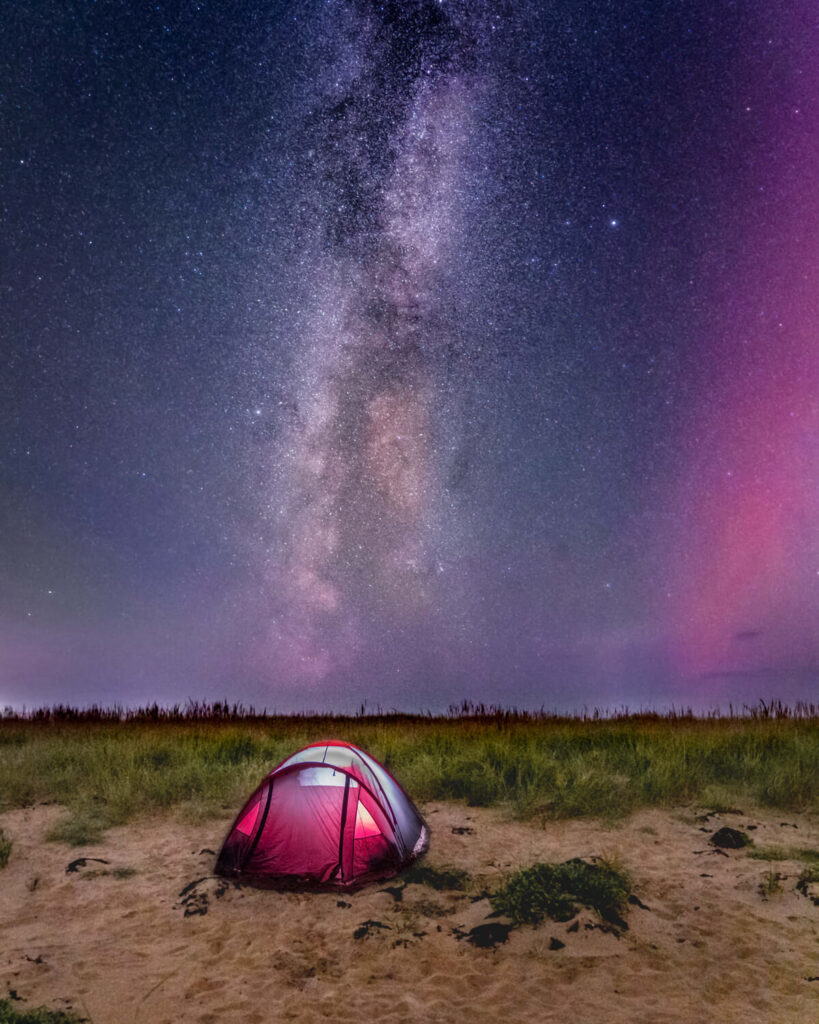
Whaligoe Steps
The Whaligoe Steps sits hidden on the eastern coast of Scotland, with no real form of signage or significant road crossings. As you head north along the east coast, before you reach the small town of Wick, you will pass a small crossroads with the signage “Cairn o’ Get”. Once you see this sign take a right turn towards the sea and you will be led down a lane towards a couple of small cottages.
The Whaligoe Steps are an ancient series of limestone steps leading down the 250ft stone cliffs to the remains of the old Whaligoe Haven harbour. Completely surrounded by towering stone walls, this small bay is an incredible place to visit. The 300-odd stone steps leading down to the harbour are believed to date back to the late 18th-century when it was used as storage for over 20 small fishing boats.
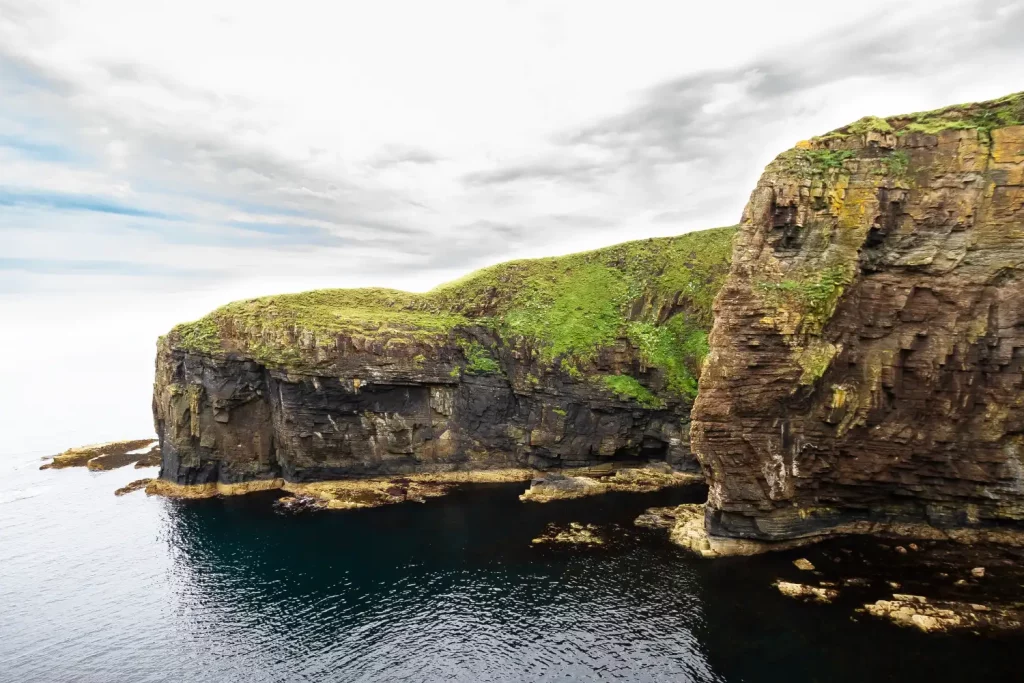
Despite the lack of fishing boats today, the steps and remaining harbour are still in fantastic condition thanks to the hard work of the local volunteers.
Castle Sinclair and Girnigoe
The history and splendour of the castles around the NC500 are simply fascinating, none more so than the ancient remains of Castle Sinclair and Girnigoe. By far our favourite castle around the North Coast 500, these silent remains tell a beautiful tale of how life in the north of Scotland used to be.
Perched perilously close to the cliff edges, just north of the town of Wick, these beautiful castle remains look like they are straight out of a fantasy film. The castle itself has had quite an eventful history, including multiple seizures, grand expansions, and family murder. The earliest parts of the castle are believed to date back to the 15th century, with expansion projects being continuously added all through to the siege of 1680, which damaged the castle so badly it was never inhabited again.
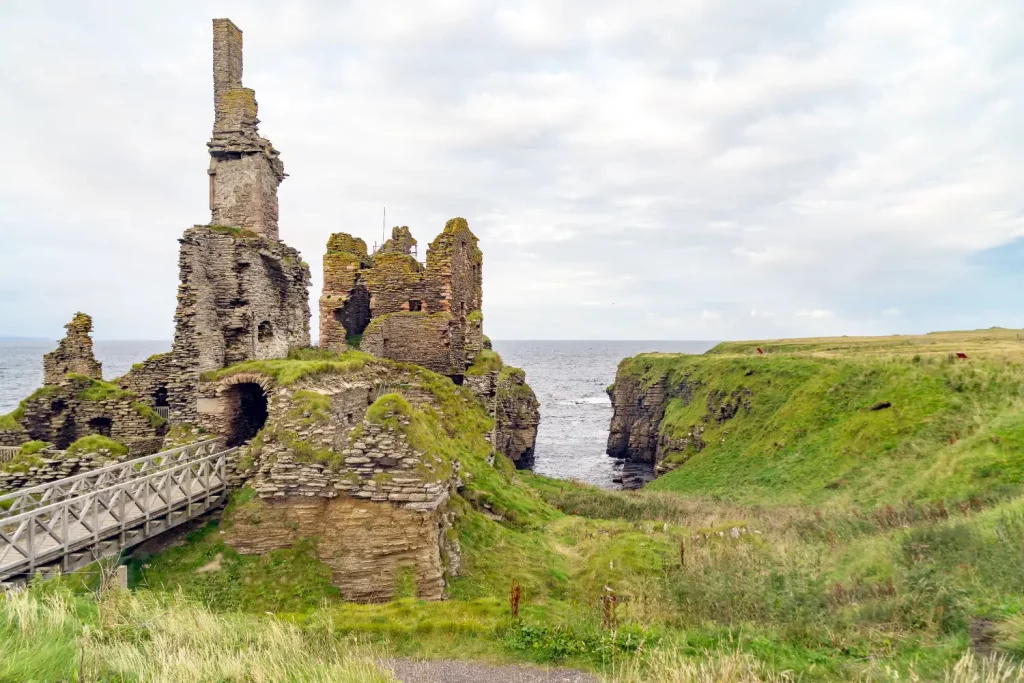
For the next 340 years, the castle remains slowly fell into decay until the beginning of the 21st century, when the Clan Sinclair Trust was formed in order to restore sites like this to a safe standard for visitors. The magnificent work these volunteers do can be seen all across the country, including the newly installed bridge access to the castle ruins of Sinclair and Girnigoe.
Upon your visit to this site, it is asked that you leave a small donation for the continual maintenance and restoration of projects such as this across Scotland.
The castle grounds are open year-round and are on a donation basis.
Duncansby Lighthouse and Stacks
Situated on the farthest reach of the northern coast of Scotland, nearby the most northernly point of Dunnet Head, is the incredible sight of the Duncansby Lighthouse, situated beside the Duncansby Stacks. Built at the beginning of the 20th century to guide boats through this perilous stretch of water, known by the title of “Hell’s Mouth”. The danger in this part of the coastal waters comes from the characteristics produced by the way the Atlantic and North Seas meet, producing eddies and flows that reach up to 10 knots.
As a result of this lively water flow, the coastal scenery around Duncansby Head is some of the most spectacular in Scotland. The main spectacle being the Duncansby Stacks, the largest of which towers 60m above the water below. The true power of the weather up here is evident in the awe-inspiring coastal towers. Over thousands of years, the winds and flows of the ocean have slowly carved the coastline down to what remains today.
The lighthouse at Duncansby is still in use today, however, it remains unmanned ever since it was fully automated in 1997.
This northern part of the UK is perhaps the best place to view the northern lights on the mainland of Scotland, due to the lack of light pollution and how far north it sits. Time your journey here to perfection and you may be able to enjoy the most spectacular, natural show of lights on the planet.
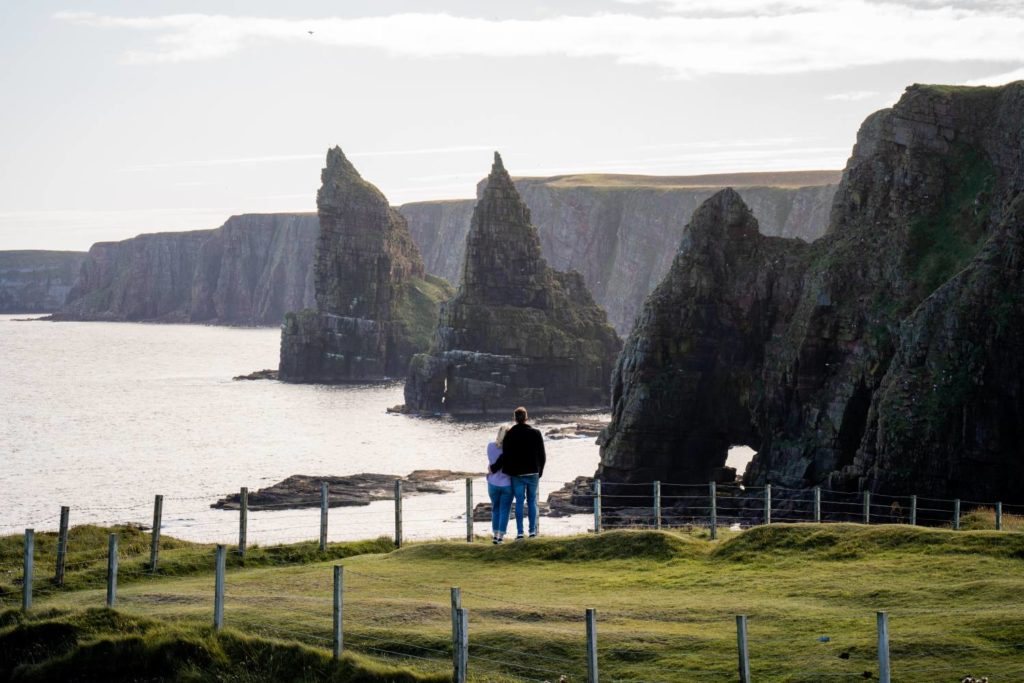
DON’T FORGET
Your trip to Scotland will be a lot more comfortable with a midge net and midge spray. These little biting bugs can be enough to ruin a trip if you don’t have the equipment to protect yourself from them. A repelling candle can also be helpful if you are sitting oustide.
John O’Groats Signpost
The most famous sight in the northern coast of Scotland and end of the countrywide, 874-mile trail from Lands End to John O’ Groats is the famous landmark John O’Groats signpost marking the end of the road. This signpost is one of the most photographed signposts in the world and draws thousands of visitors every single year, all eager to capture a picture at the edge of the world.
The sign that you visit today is actually a replacement of the original, which was installed in 1964 on private land and required a fee to have a photo taken beside it. In 2013 the original site was bought as part of a hotel renovation project, and upon completion, a new sign was installed in the original location available to public access.
If you wish to view the original and have your picture taken with customisable text on the sign, you can do so at the John O’Groats Caravan Park 180m from the original site.

Strathy Point Lighthouse
Constructed in 1958, Strathy Point Lighthouse remains a fully functional lighthouse, warning passing ships of the dangers lying in wait along the northern coast of Scotland. Fully automated in 1997, the lighthouse no longer has a fulltime worker onsite. Instead, the two units beneath the lighthouse have been converted into holiday accommodation available for short and long-term rent.
If you fancy sleeping on the edge of the world, the minimum length of rent is 1 week and costs start from around £400/week.
Regardless of whether you are wishing to stay in these residences, the views from the coastal walk by Strathy Point Lighthouse are worth the visit. This was another spot where we wild camped during our trip around the NC500 and the morning view from our tent was spectacular.
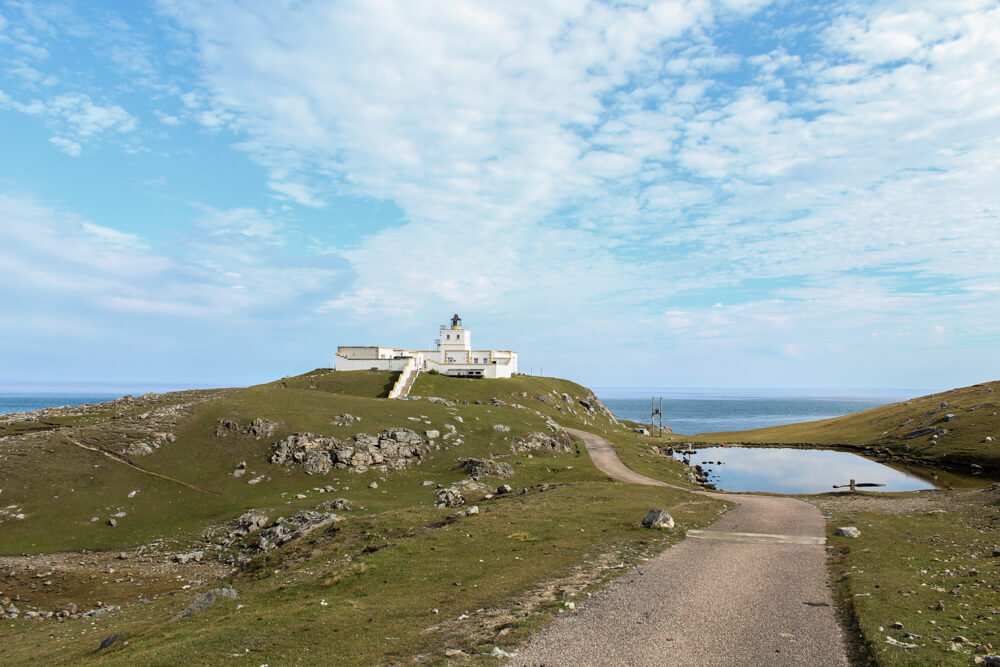
Skerray Bay
This quaint, off-the-beaten-track harbour is a beautiful spot to stretch your legs and even brave a swim in the calm, sheltered water. Skerray is a small highland village that features a post office and a small shop, with not much else to it. By the harbour is a patch of grass that is frequently used by campers, which functions on a donation basis per night.
We stopped off here on a particularly warm, sunny day and decided it was the perfect time to jump in and go for a swim. The water is definitely colder than it looks!
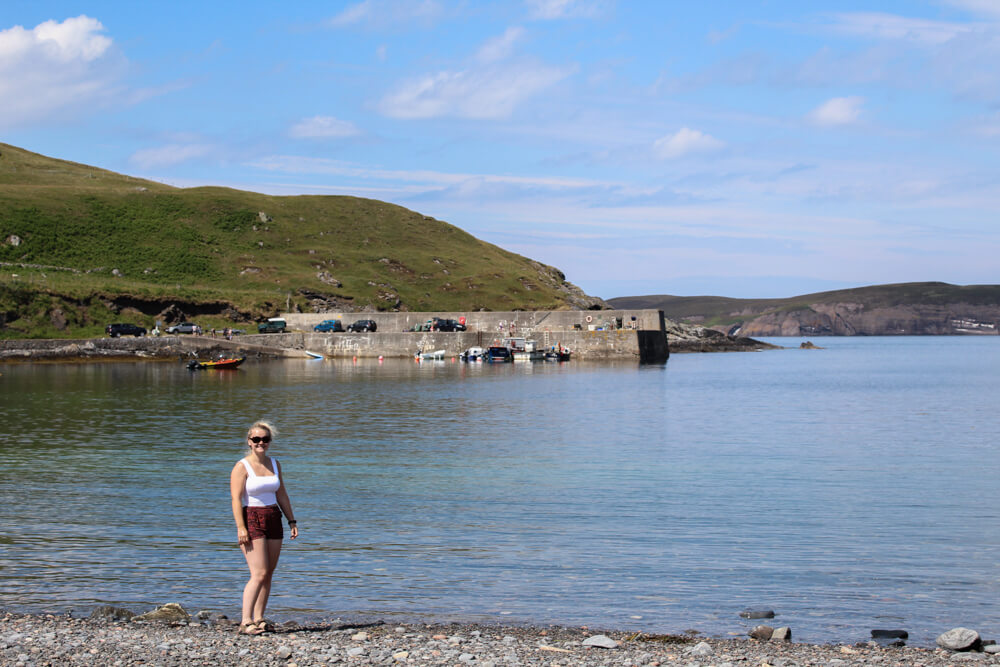
Coldbackie Beach
A hidden gem on the north coast of Scotland, sitting beneath the towering mountains by the coast and concealed from the view of the road by a protective barrier of sand dunes, Coldbackie Beach is a true treat for lovers of white sand and blue water. As you drive west towards the village of Tongue, keep an eye out for a sliver of white and blue on your right-hand side.
A layby at the side of the road will allow you to park up and begin the steep descent down towards the beach. This is quite a tricky climb, especially when the ground is wet underfoot, so take care and wear good shoes. Upon reaching the beach, take a moment to appreciate the seclusion around you and stretch your legs along the shore.
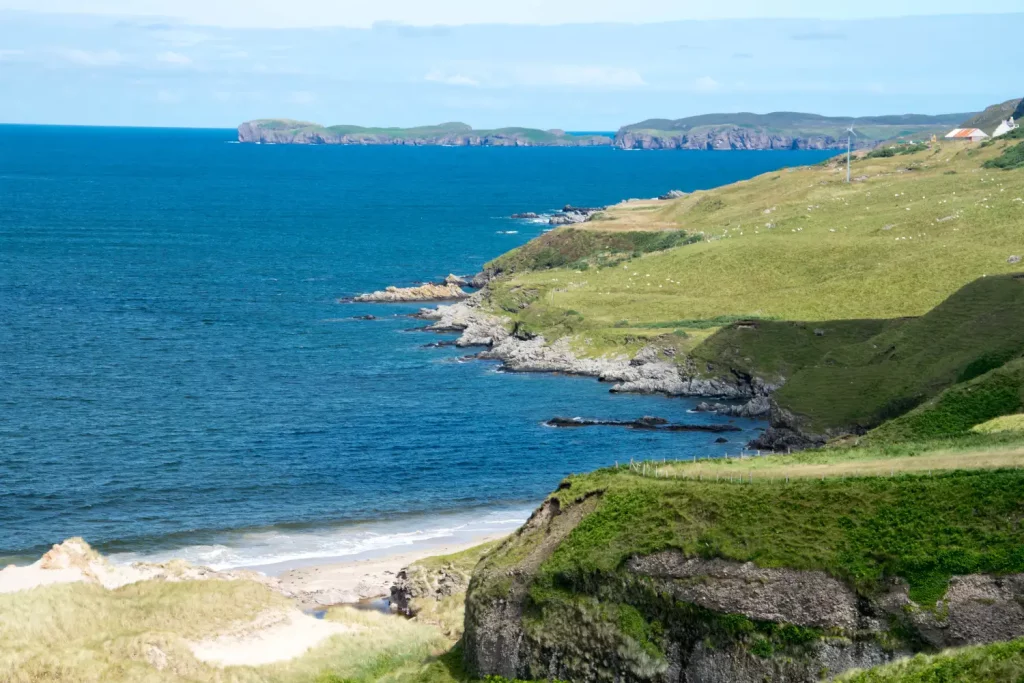
Destination North Coast Map
If you are planning an adventure to the North Coast of Scotland, make sure you have all the resources you need to make the most of your trip. Our Destination North Coast Map is the perfect addition to any traveller’s toolkit. With detailed information on all the best spots, along the NC500, this map is your ultimate guide to exploring the rugged beauty of Scotland’s north coast.
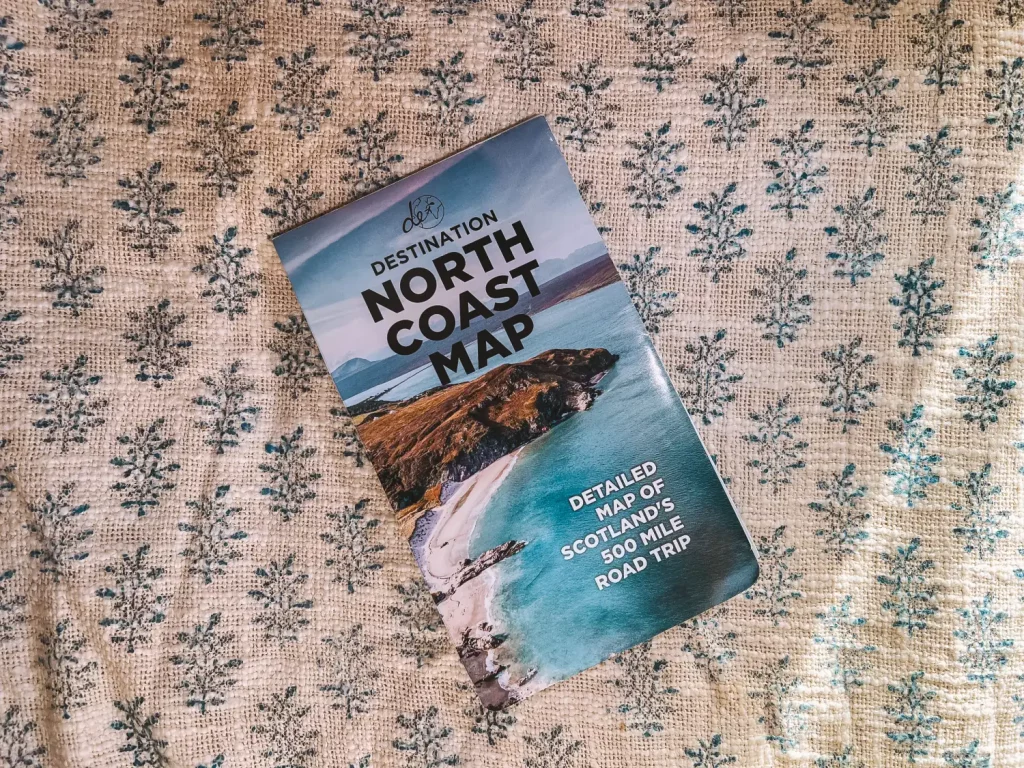
Smoo Cave
A cave of mystery, and fascination, and one that time itself forgot lies just outside the small town of Durness. Smoo Cave has a very interesting history, dating well back to the first days of the Viking settlers in the UK. As you enter through the 50ft opening to Smoo Cave (one of the largest Sea Cave entrances in the UK), you enter into the story for the ages of this part of the country.
What you will learn about this part of Scotland upon visiting these limestone chasms is simply fascinating. You will learn about the dark history of the caves, including how it was used to dispose of up to 18 bodies in the 17th-century by the infamous Donald McMurdo, who is believed to have been working as Smoo Caves‘ first-ever tour guide (be careful you leads you into the caves).
You will also learn about the vast historical significance of this part of Scotland, including how the Vikings used to store their boats in the cave, and how due to continental drift, this part of Scotland once sat where South America is today.
The caves themselves are forever expanding thanks to the hard work of the local cave exploration team. A lot of the cave openings are currently inaccessible due to being underwater, however, it is believed that during the time of the Vikings, the lower sea levels meant that the cave floor was actually about 10ft lower than it is today, giving access to the huge expanse underneath.
You can visit the Smoo Caves at any time of the day, with the main cave remaining open to the public 24-7. If you wish to explore deeper into the cave system, which is only accessible by boat, you will need to take part in an organised tour. The tour is subject to the local weather, as even a little rainfall can make the cave inaccessible. Due to this, there are no advance bookings.
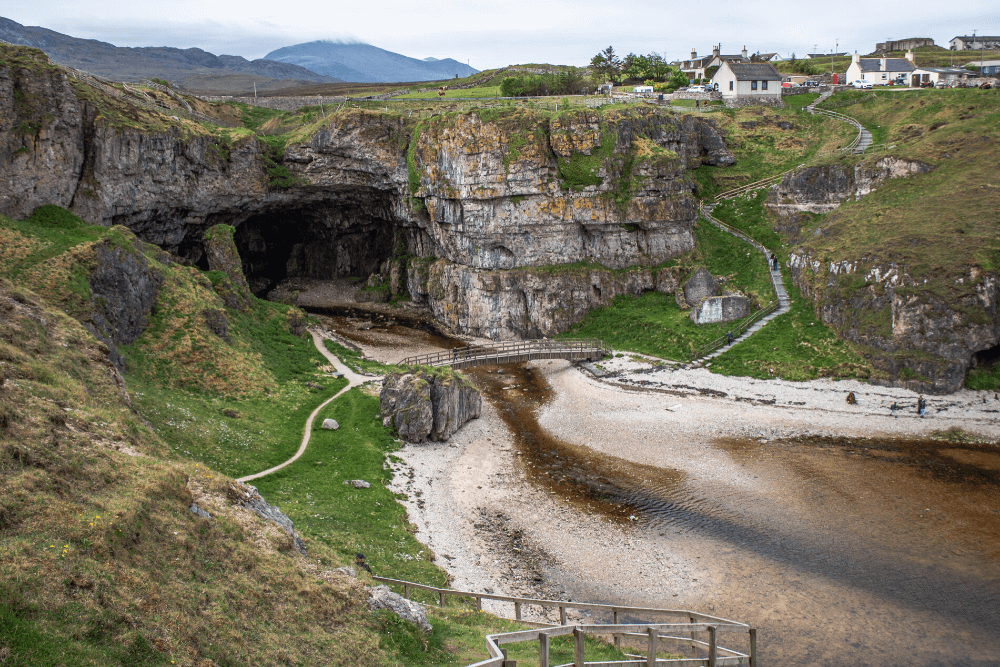
Handa Island
Stunning cliffside views, turquoise blue waters, and incredible wildlife all around, Handa Island is a special place on the North Coast 500. Between the natural unbelievable natural scenery and some 100,000 seabirds that call this island home, it is a place made for nature enthusiasts.It is quite a small island, with a complete walking loop around the circumference only taking a few hours, perfect for a day out on the NC500 road trip. Upon arriving on the island, you will be greeted by a volunteer with the RSPCA who will give you a quick introduction to the island, including where you can go and what to look out for.
Due to the fact that the island is a nature reserve and a crucial resting place for many seabirds, it is asked that you take extreme care not to disturb any of the wildlife that is present on the island. You are also asked to stick to the existing pathways and boardwalks to limit the impact on the natural environment of the area.
The walk around the island is absolutely breathtaking, made even better by the stunning views of mainland Scotland across the light blue water. Keep an eye out for dolphins and whales off the shore and as you make your way across to the island by boat.

In order to reach the island, you will need to catch a small, ribbed boat from Tarbet across to the island, normally running between April to September. The furry runs six days a week, with no service on Sundays, and is of course art the discretion of the captain based on weather conditions. If you wish to know more about the ferry, you can find the timetable on the website.
If you are looking for a good bag for your time exploring the North Coast 500, we can highly recommend the Wandrd Bag PRVKE 41L, especially if you are carrying camera equipment around. If you are looking for a smaller backpack, The Nest by Tropicfeel is one of the most comfortable bags I have ever owned.
Kylesku Bridge
Not a culturally significant sight along the NC500, but a beautiful one nonetheless. Kylesku Bridge is one of the more famous bridges on this road trip, popular for the stunning contrast between the sleek, modern look of the bridge and the rugged, wild nature of the surrounding landscape.
There is a large car park beside the bridge and it is one of our favourite places to stop off and soak in the surrounding views.
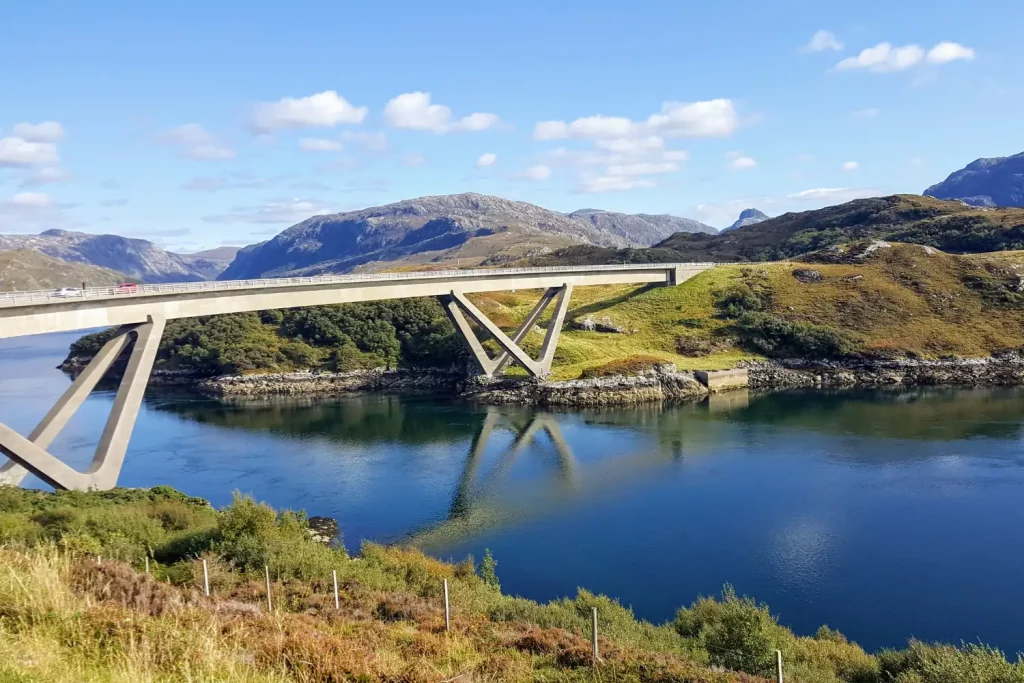
Ullapool Harbour
Ullapool is the main harbour town to the outer islands of Lewis and Harris, which was voted No.1 island in Europe in 2014. This picturesque, fishing town sits on the banks of Loch Broom, surrounded by the towering mountains of the Scottish highlands. In addition to these spectacular views, the history in this part of Scotland is simply fascinating, with evidence of human settlements dating back 2,500 years.
As you walk along the shorelines of Ullapool will show you this history, with a fort system just north of the town of Ullapool, as well as evidence of an old Viking fish trap, visible at low tide dating back to the 8th century.
If the history in this part of the world doesn’t interest you, the town of Ullapool itself is a beautiful place for a wander. Stretch your legs along the peaceful, harbour-front street, lined with quaint houses and shops. Another one of our favourite things to do in Ullapool is going for a walk and soaking up the views from the top of Ullapool Hill.
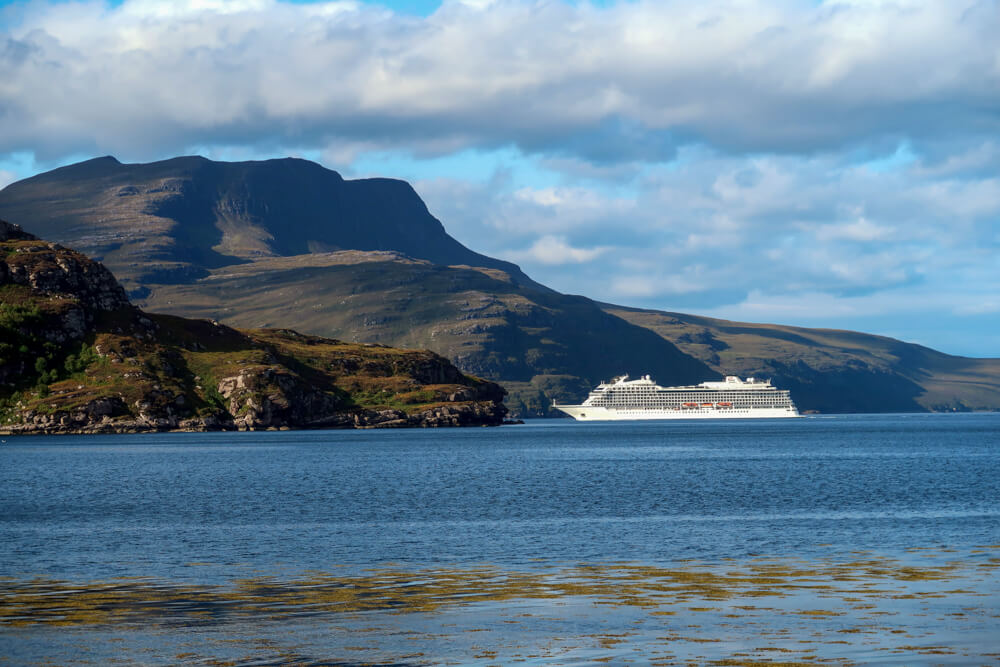
Falls of Measach
Crashing 45-metres through the Corrieshalloch Gorge is the breathtaking sight of the Falls of Measach. Over centuries of heavy rain and raging torrents, the River Droma has carved the deep, box canyon out of the ancient rock in this part of Scotland. This beautiful display of the power of nature has resulted in one of the most spectacular waterfalls in Scotland, and is a sight that you need to see on your North Coast 500 road trip.
After you park up in the newly built car park, a short walk down the wheelchair-accessible track will bring you to the Victorian suspension bridge, built by one of the chief engineers who built the iconic Forth Road Bridge, John Fowler. From this bridge, you can gaze down into the abyss of the crashing water beneath you.
If you fancy a more photogenic view, continue on the path for another 10-or-so minutes and you will reach a custom-built viewing platform. This platform gives you a spectacular view of the entire height of the waterfall, including the beautiful suspension bridge you just crossed.
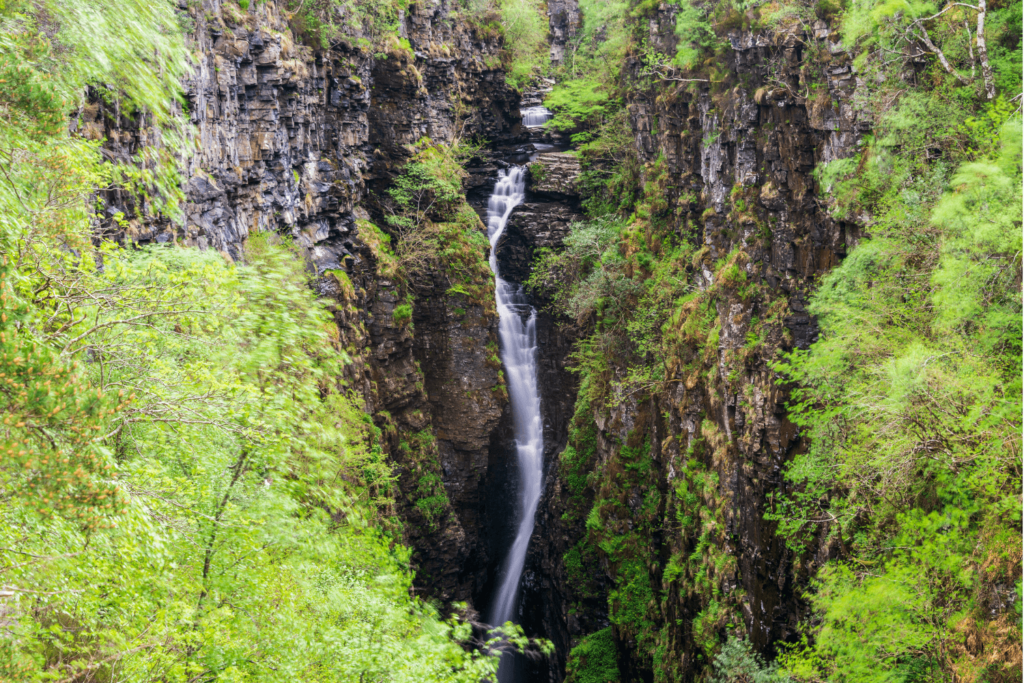
Sheildaig
With so many quiet, harbour towns along the NC500 road trip, you think they would eventually lose their charm. However, as the white-washed buildings of Shieldaig’s main street, complimented by the still waters of Loch Shieldaig, you will soon realise that this is simply not possible. Each one you visit is as beautiful as the next.
The town of Shieldaig prospers mostly from the bountiful supply of herring that can be found in Loch Shieldaig, which has supplied the town and the surrounding lands since the days of the Vikings. It is also thanks to these still, peaceful waters that visitors from all over the world choose to visit this small town and enjoy a moment of clarity from the busy world outside.
Another very attractive side to Shieldaig that many other towns lack is the provision of parking for visitors off of the iconic high street, meaning the view of the buildings and loch are not affected by the increase in traffic.
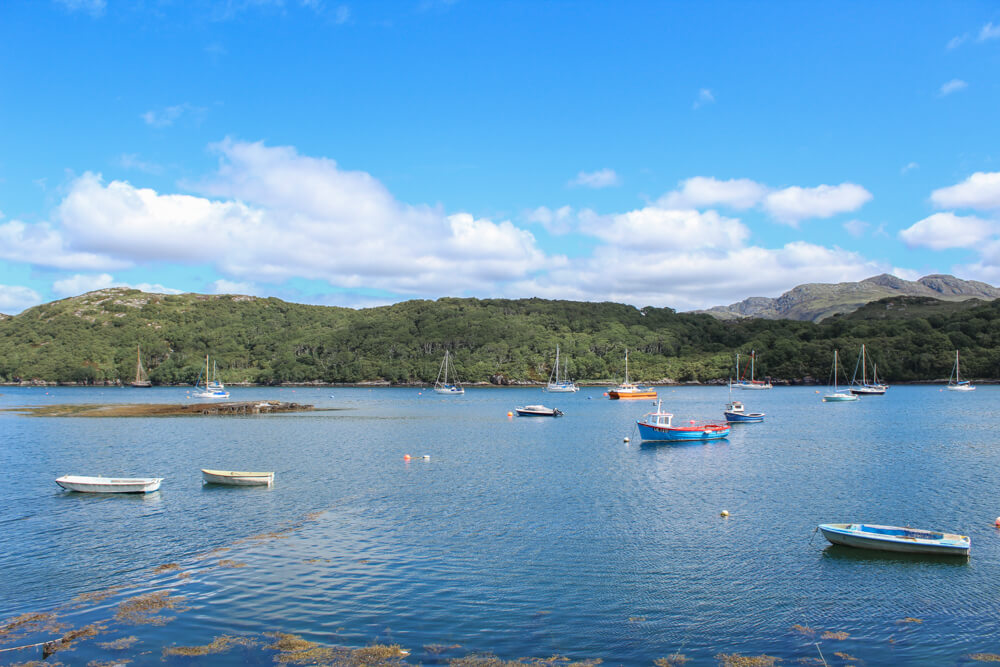
Bealach na Ba Pass
Without a doubt, one of the most spectacular drives in the whole of the United Kingdom is the winding route of the Bealach na Ba pass. Stretching up through the mountain ranges of the Applecross peninsula, this pass features as the third highest road in Scotland and is the steepest ascending road in the UK, going from sea level to 626 metres.
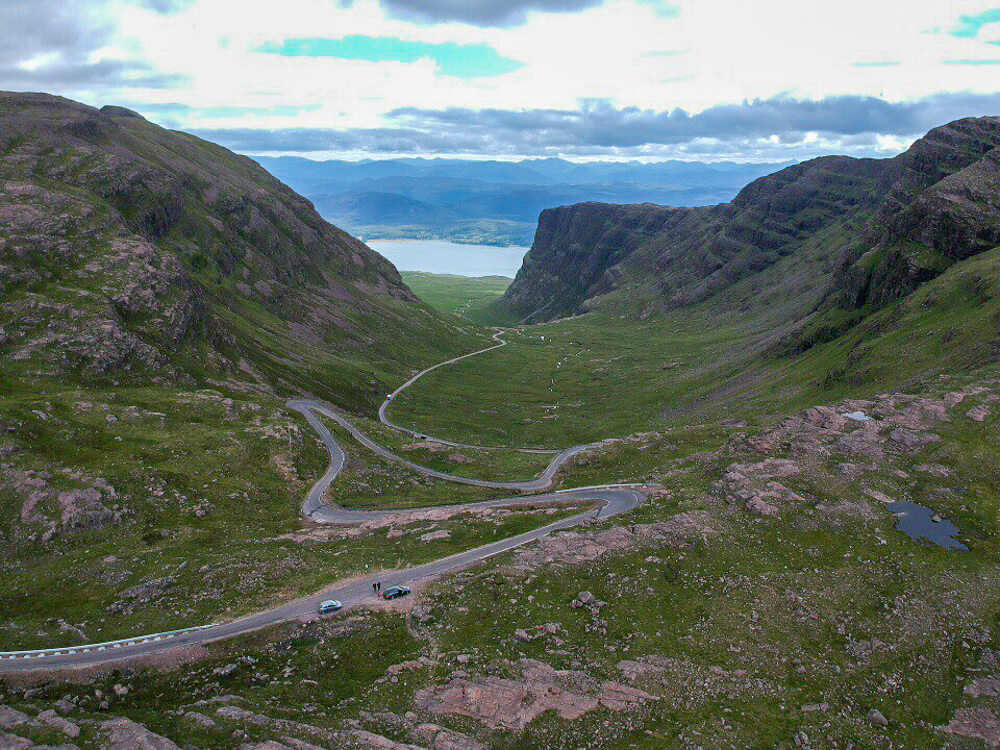
This mountain pass was first constructed in 1822, as a method of getting cattle from the town of Applecross to the markets in central Scotland. Hence the name Bealach na Ba, or Pass of the Cattle. Until the year of 1970, this route was the only road to and from Applecross, with a road more suitable for large vehicles now available leading through Kenmore and Shieldaig.
The views from the top of this road are simply spectacular, as on a clear day you are given pristine views of the mountainous silhouette of the Isle of Skye to the west. Make sure you stop off at the viewpoint at the top of the pass before heading down the other side to Applecross.
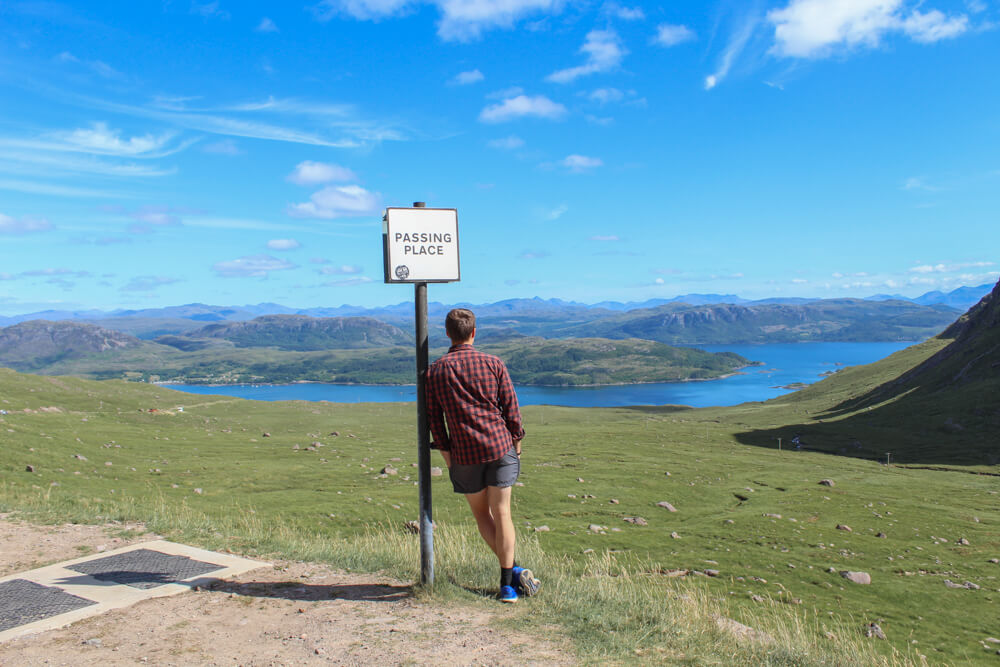
The road through the Bealach na Ba is not suitable for large vehicles (anything over 16ft in length) due to the tight twists and turns along the way. If you are driving a large vehicle you are advised to take the other route around the north of the peninsula. This takes a little bit longer but the views are equally as breathtaking.
Applecross
Once you have passed through the intimidating and beautiful Bealach na Ba pass you will arrive into the small town of Applecross. Sitting right on the western coastline of Wester Ross (yes Game of Thrones fans, I know what you’re thinking), this tiny village has spectacular views across the water to the small island of Raasay and beyond to the Isle of Skye.
The remote community of Applecross was once made up of two very separate communities. The Bealach na Ba road, which was constructed in 1822, continued south of Applecross to the smaller village of Toscaig, however, there would not be a road north of here for another 150 years. Until then, the communities further north on the Applecross peninsula were only accessible by sea, or experienced horse and motorbike riders.
The village you see today remains as quaint and undisturbed as it would have 200 years ago, with not much but a harbour, a high street, and a local tavern. This pub is the perfect place to end the night, with a fantastic, warm atmosphere, live music and good food and drink to match.
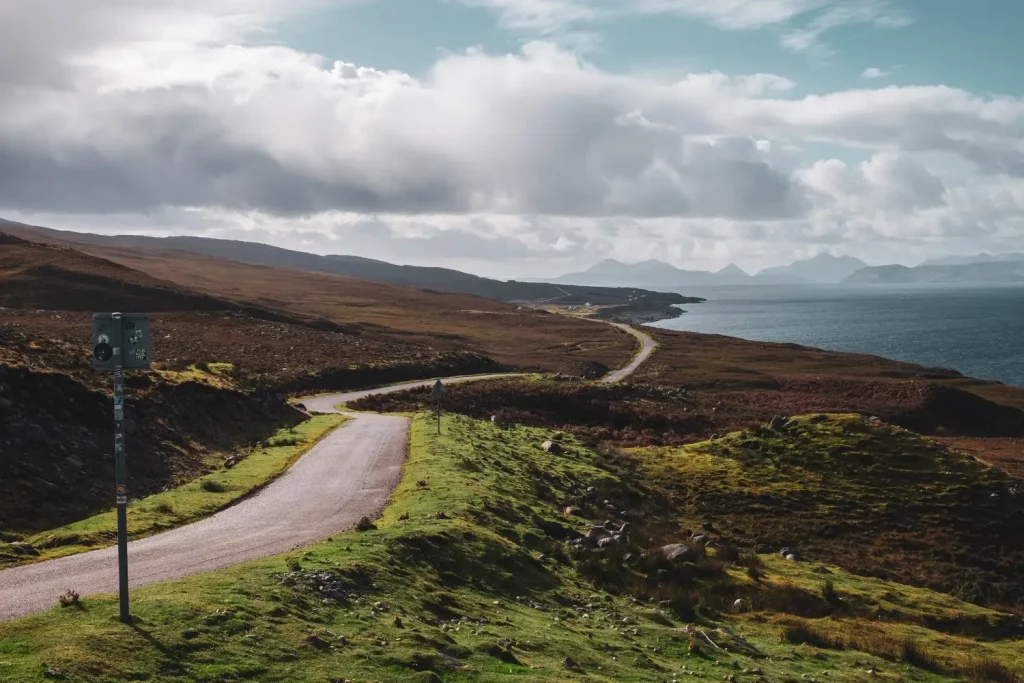
Ceannabeine Village Trail
If you are looking for a history lesson with a view then the Ceannabeine Village Trail is one for you. Sitting outside the village of Durness, the ruins of the old Ceannabeine (meaning “end of the mountains”) township can be found along a guided boardwalk. With views over one of Scotland’s most spectacular beaches, the Ceannabeine Village Trail tells the story of how locals lived through the 18th century in this remote village.
Ceannabeine Beach
Ceannabeine Beach is a beautiful and secluded spot located on the north coast of Scotland. This beach has pristine sands and turquoise waters although keep in mind that no matter what time of year you visit, the water will still be cold!
The beach is surrounded by stunning cliffs and rolling hills, making it an ideal spot for hiking and exploring and if the weather conditions are right, Golden Eagle zipline gives you the best views over the beach.
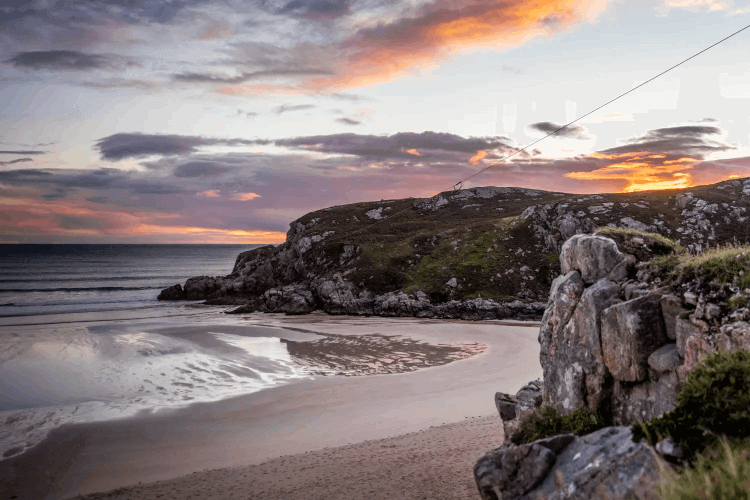
Achmelvich Beach
Achmelvich Beach in Scotland is a true hidden gem. Located on the west coast near Lochinver, Achmelvich Beach boasts crystal clear turquoise waters and pristine white sand.
The beach is surrounded by rugged cliffs and rolling green hills, creating a breathtakingly beautiful backdrop for a day of sunbathing, swimming, and relaxation. It is one of our favourite beaches for wild swimming on the NC500 due to how clear the water is.
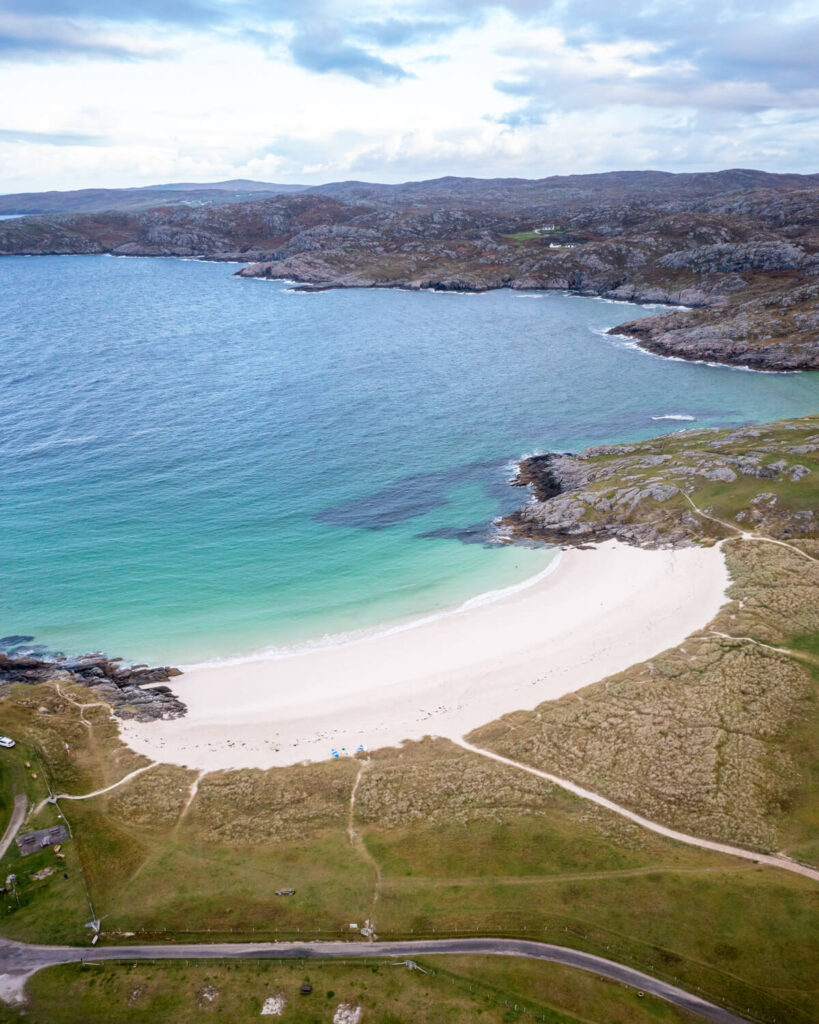
Before You Leave for the North Coast 500
Before you head off on your trip around the NC500, there are certain things you will need to get organised to ensure a smooth trip. These include how to get around the route, including being aware of single track roads, etc., what to pack for Scotland, where to stay along the route and what travel insurance to book.
How Do I Get Around?
Given the remote location of the NC500 and the majority of the sights along the route, the best way to get around this road trip is by driving. There are of course other methods that are still popular, such as cycling and hiking, however, if you have a short amount of time on the route, neither of these are very suitable.
As for public transport, the use around the NC500 is understandably difficult due to how remote each location is, however, with the increasing problem of congestion along the route, this is a good option to research if you have time. If it is something that interests you, you can read a public formed itinerary of how to get around the NC500 by public transport over here.
If you are looking to rent a cosy, reliable and luxurious campervan for your trip along the NC500, we recommend hiring through Spaceships
Browse the full range of vehicles on offer at Spaceships over here.
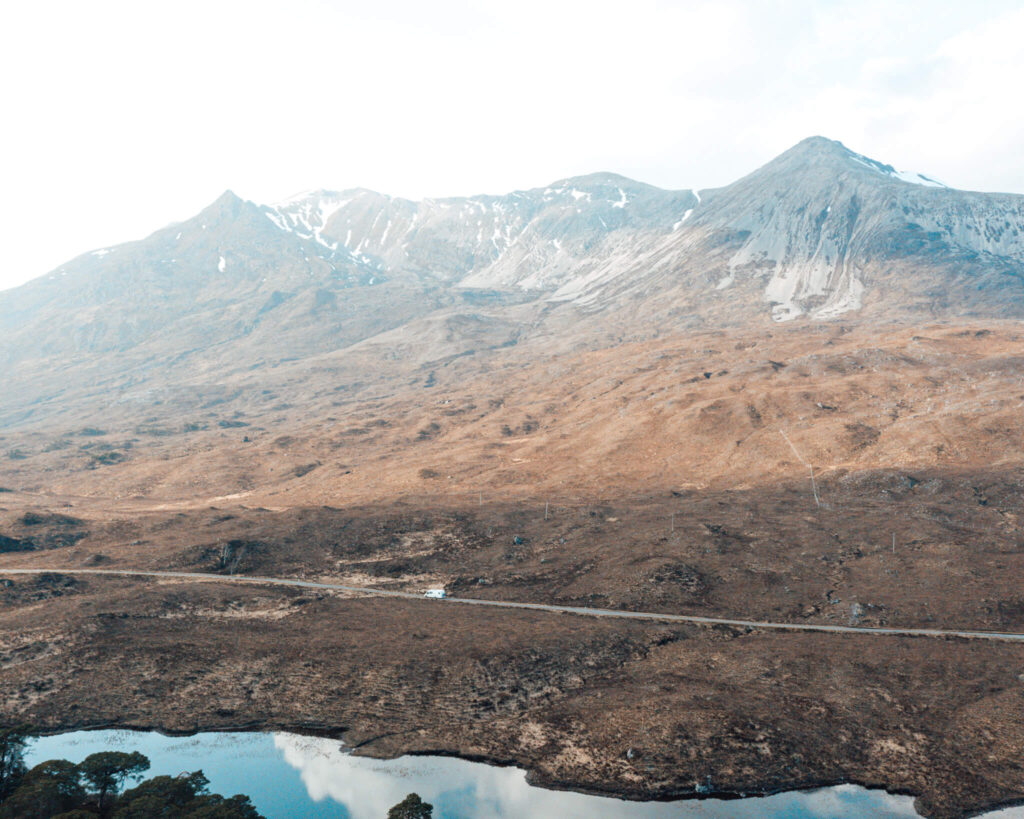
Where to Stay on the NC500
There is a wide range of accommodations around the NC500 route, so you will not be short on options. Depending on how long you are spending in each area will depend on how long you spend in that location. It is worth bearing in mind that some accommodations will require you to stay a minimum number of nights so it is worth researching this when you are planning your North Coast 500 itinerary.
Our new book North Coast 500 Where to Eat and Stay shares the best places to eat and stay around the NC500 and includes whether places are dog friendly, accessible, have wifi and EVC ad whether they cater to dietry requirements.
The remoteness in the highlands of Scotland will leave you with little choice of accommodation in each location along the NC500, however, there are still enough options to choose from to ensure a comfortable trip. These are mostly in the shape of B&Bs, Airbnbs, converted cottages and other quirky accommodations.
Depending on how adventurous you are, there may be more accommodation choices than just the above, often with an even better view. Caravan and camping sites are abundant along the NC500, drawing camping enthusiasts from all over the world. For some of the most spectacular bedside scenery along the North Coast 500, we recommend packing a tent and getting in touch with nature for the week.
We travelled along the North Coast 500, camped in our trusty Vango tent, on a mixture of campsites and wild sites. Wild camping is a fantastic way to enjoy the beauty of the highlands, however, it must be done respectfully. Read our full guide to Wild Camping if you wish to give it a go so you know everything you need to for a comfortable and sustainable trip.

What Should I Pack?
When it comes to packing for a trip to Scotland there is one item of clothing that you are going to need all year round: a waterproof. It rains in Scotland on average 250 days a year, meaning that during your road trip you will probably experience at least a drizzle of rain. Due to this, the number one item on any Scotland packing list is a good waterproof jacket (men’s / women’s).
During the winter months, you will most likely experience snow, however, temperatures usually sit around freezing, so it is not too cold. For your reference, the average temperatures in Scotland are listed below during each season.
Spring (March, April, May) – 5-10 degrees C
Summer (June, July, August) – 15 degrees C
Autumn (September, October, November) – 5-10 degrees C
Winter (December, January, February) – 0-5 degrees C
As you can see, the weather never really gets above the teens, with anything over 25 degrees C considered a heatwave. The best way to pack for your trip to the highlands is with layers that can be added and removed as you need them. You will definitely need a hat and gloves during the colder months and will most likely need sunscreen to protect you on the long days in the open.
We would also recommend taking our NC500 guidebooks with you on your journey. This will help you plan your itinerary and ensure that you don’t miss out on any of the best places to go on the NC500. Our Destination NC500 guidebook is well paired with NC500 Where to Eat and Stay and you can buy the combo here.
Given the beautiful sights and scenery that you are no doubt going to see around Scotland, we highly recommend packing a good camera for your trip. If you want to read more about the cameras we use and why we love them, check out the link below.
Photography Equipment
Main Photography Camera – Sony A7v Mirrorless Camera and Sony A7iii Mirrorless Camera
Microphone – Sony Mic ECM-B1M
Main Lens – Tamron 17-28mm f/2.8
Zoom Lens – Tamron 70-180mm f/2.8
Camera Tripod – ZOMEI Z669C Camera Tripod
Gorilla Pod – JOBY JB01507-BWW GorillaPod
Action Camera – GoPro Hero 11 and Insta 360 One RS
Drone Camera – DJI Mavic Pro 3
Camera Bag – Wandrd PRVKE 41L and The Nest by Tropicfeel
Phone Tripod – Manfrotto MKPIXICLAMP-BK, Mini Tripod with Universal Smartphone Clamp
Sturdy Phone Tripod & Selfie Stick – ATUMTEK 61″ Selfie Stick Tripod, Sturdy Phone Tripod Stand with Wireless Remote
Hard Drives – LaCie Rugged Mini, 5TB, 2.5″, Portable External Hard Drive
SSD – SanDisk Extreme Pro 1TB Portable NVMe SSD
Travel Adapter –Worldwide Travel Adapter Universal Travel Plug with 4 USB Ports+Universal AC Socke
What is the Best Travel Insurance for the North Coast 500
I know travel insurance is the least enjoyable thing to purchase and look at when you’re planning a trip, however, you wouldn’t want to be without it in the event that something happened. Accidents can happen anywhere and the extortionate medical bills will ruin your trip if you are not covered.
To ensure you have a stress-free trip with no worries about potential medical bills, make sure you cover yourself when you travel. We can recommend using SafetyWing, a backpacker-friendly and cheap insurance company that provides good coverage and support. It is also nomad-friendly, unlike most other insurance companies, meaning you do not need to worry about being out of your home country for too long.
Get a quote for your travel insurance right here and get covered!
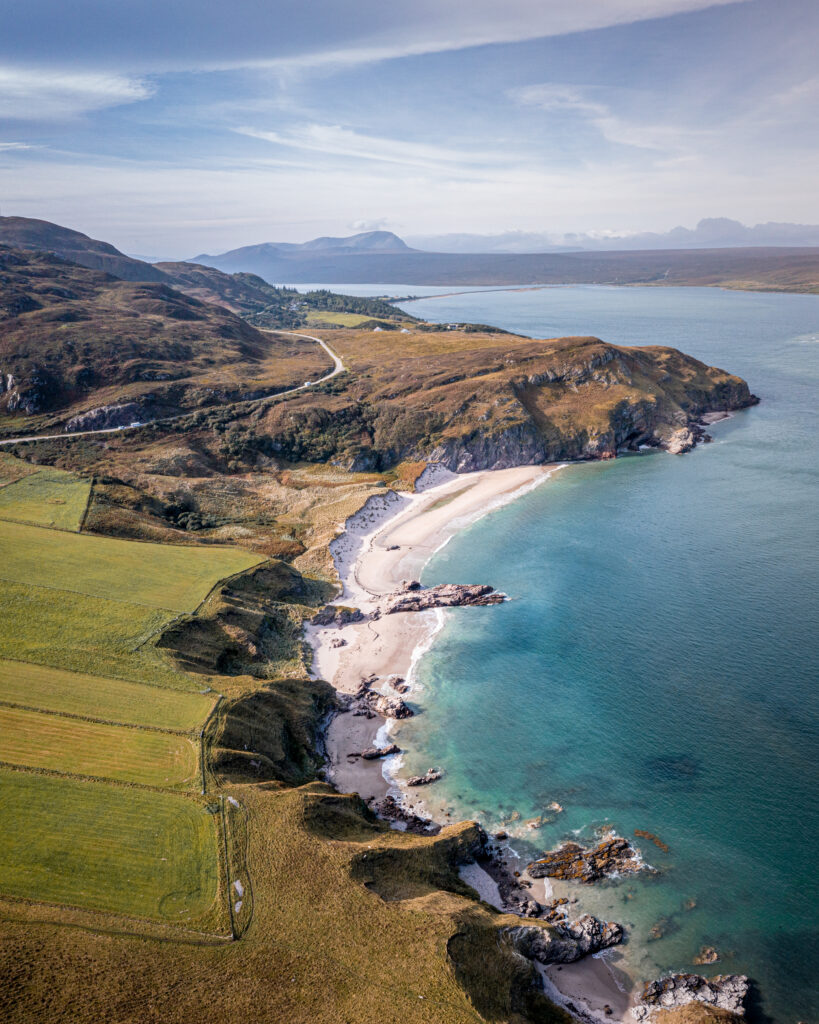
So there you have it, all of the best sights along the North Coast 500, including castles, cliff views, and stunning harbour towns. If you have visited the NC500 recently, let us know what you thought of the sights listed above, or if you have any suggestions let us know in the comments below.
As always, sharing is caring so make sure to share this guide with your family and friends and inspire them to head off on their own North Coast 500 adventure. If you are planning the trip for yourself, make sure you have a look at the rest of our Scotland content for more inspiration to our beautiful home country.
When you set off on your own adventure, be sure to tag us in your photos on Instagram and we will share them with the rest of our community. In the meantime, why not follow us over there to see what we are currently up to and keep up with us on our Instagram Stories.
Now Read:
This article may contain affiliate links that provide us with a small income. For more information read our Affiliate page.
Pin it for later!
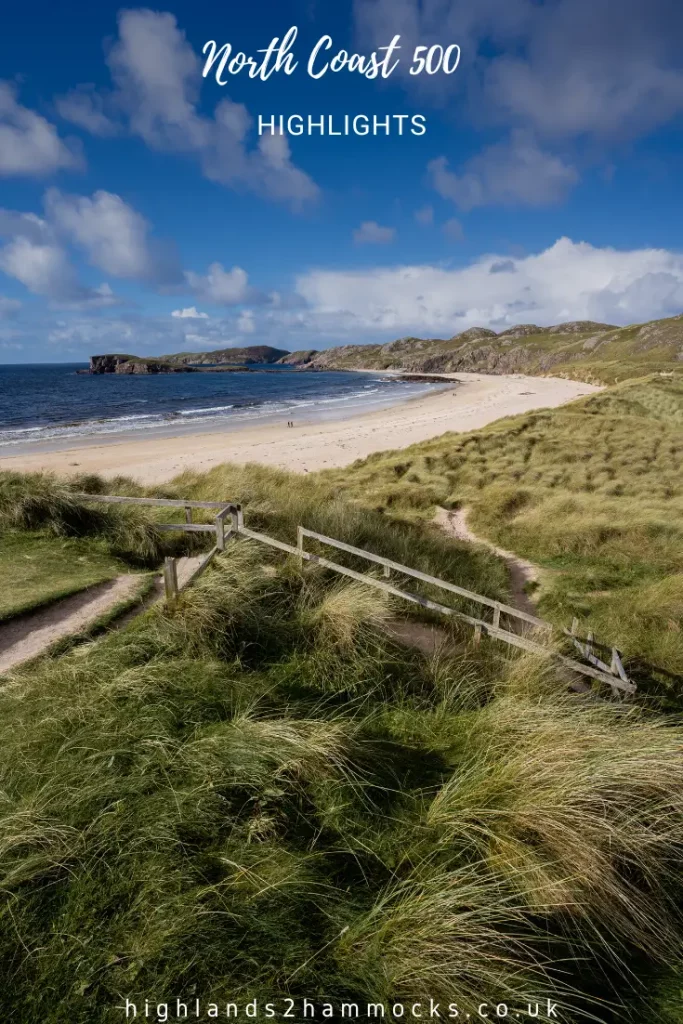


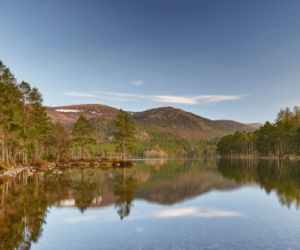
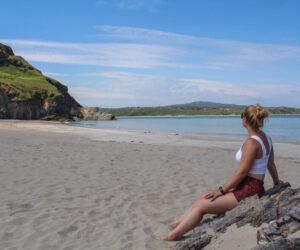
Pingback: Complete Guide to the Duncansby Stacks and Lighthouse | highlands2hammocks
Pingback: Complete Guide to Coldbackie Beach - Scotland's Hidden Gem | highlands2hammocks